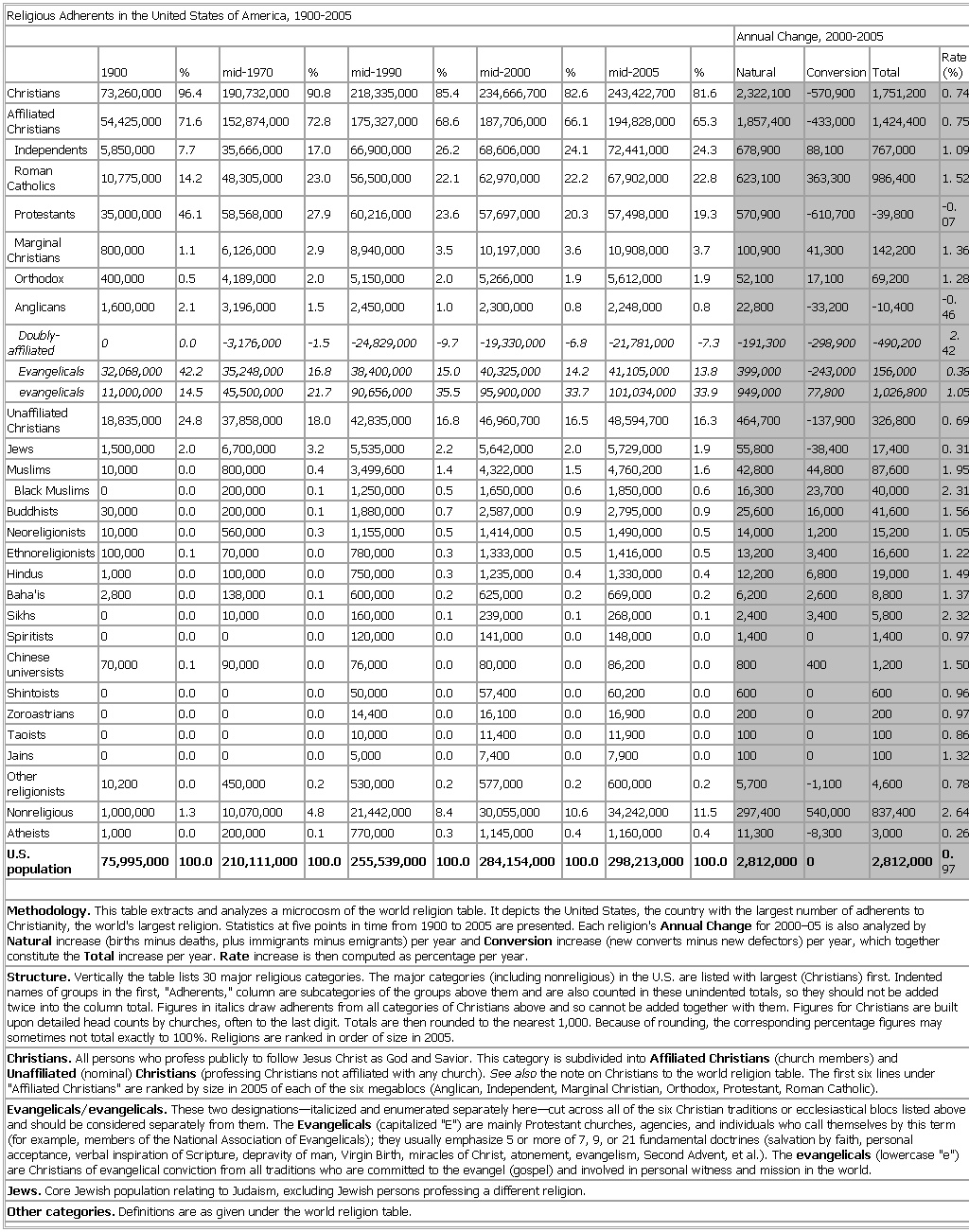- Religious Adherents in the United States of America, 1900-2005 3
-
▪ TableReligious Adherents in the United States of America, 1900-2005Annual Change, 2000-20051900 % mid-1970 % mid-1990 % mid-2000 % mid-2005 % Natural Conversion Total Rate (%)Christians 73,260,000 96.4 190,732,000 90.8 218,335,000 85.4 234,666,700 82.6 243,422,700 81.6 2,322,100 -570,900 1,751,200 0.74Affiliated Christians 54,425,000 71.6 152,874,000 72.8 175,327,000 68.6 187,706,000 66.1 194,828,000 65.3 1,857,400 -433,000 1,424,400 0.75Independents 5,850,000 7.7 35,666,000 17.0 66,900,000 26.2 68,606,000 24.1 72,441,000 24.3 678,900 88,100 767,000 1.09Roman Catholics 10,775,000 14.2 48,305,000 23.0 56,500,000 22.1 62,970,000 22.2 67,902,000 22.8 623,100 363,300 986,400 1.52Protestants 35,000,000 46.1 58,568,000 27.9 60,216,000 23.6 57,697,000 20.3 57,498,000 19.3 570,900 -610,700 -39,800 -0.07Marginal Christians 800,000 1.1 6,126,000 2.9 8,940,000 3.5 10,197,000 3.6 10,908,000 3.7 100,900 41,300 142,200 1.36Orthodox 400,000 0.5 4,189,000 2.0 5,150,000 2.0 5,266,000 1.9 5,612,000 1.9 52,100 17,100 69,200 1.28Anglicans 1,600,000 2.1 3,196,000 1.5 2,450,000 1.0 2,300,000 0.8 2,248,000 0.8 22,800 -33,200 -10,400 -0.46Doubly-affiliated 0 0.0 -3,176,000 -1.5 -24,829,000 -9.7 -19,330,000 -6.8 -21,781,000 -7.3 -191,300 -298,900 -490,200 2.42Evangelicals 32,068,000 42.2 35,248,000 16.8 38,400,000 15.0 40,325,000 14.2 41,105,000 13.8 399,000 -243,000 156,000 0.38evangelicals 11,000,000 14.5 45,500,000 21.7 90,656,000 35.5 95,900,000 33.7 101,034,000 33.9 949,000 77,800 1,026,800 1.05Unaffiliated Christians 18,835,000 24.8 37,858,000 18.0 42,835,000 16.8 46,960,700 16.5 48,594,700 16.3 464,700 -137,900 326,800 0.69Jews 1,500,000 2.0 6,700,000 3.2 5,535,000 2.2 5,642,000 2.0 5,729,000 1.9 55,800 -38,400 17,400 0.31Muslims 10,000 0.0 800,000 0.4 3,499,600 1.4 4,322,000 1.5 4,760,200 1.6 42,800 44,800 87,600 1.95Black Muslims 0 0.0 200,000 0.1 1,250,000 0.5 1,650,000 0.6 1,850,000 0.6 16,300 23,700 40,000 2.31Buddhists 30,000 0.0 200,000 0.1 1,880,000 0.7 2,587,000 0.9 2,795,000 0.9 25,600 16,000 41,600 1.56Neoreligionists 10,000 0.0 560,000 0.3 1,155,000 0.5 1,414,000 0.5 1,490,000 0.5 14,000 1,200 15,200 1.05Ethnoreligionists 100,000 0.1 70,000 0.0 780,000 0.3 1,333,000 0.5 1,416,000 0.5 13,200 3,400 16,600 1.22Hindus 1,000 0.0 100,000 0.0 750,000 0.3 1,235,000 0.4 1,330,000 0.4 12,200 6,800 19,000 1.49Baha'is 2,800 0.0 138,000 0.1 600,000 0.2 625,000 0.2 669,000 0.2 6,200 2,600 8,800 1.37Sikhs 0 0.0 10,000 0.0 160,000 0.1 239,000 0.1 268,000 0.1 2,400 3,400 5,800 2.32Spiritists 0 0.0 0 0.0 120,000 0.0 141,000 0.0 148,000 0.0 1,400 0 1,400 0.97Chinese universists 70,000 0.1 90,000 0.0 76,000 0.0 80,000 0.0 86,200 0.0 800 400 1,200 1.50Shintoists 0 0.0 0 0.0 50,000 0.0 57,400 0.0 60,200 0.0 600 0 600 0.96Zoroastrians 0 0.0 0 0.0 14,400 0.0 16,100 0.0 16,900 0.0 200 0 200 0.97Taoists 0 0.0 0 0.0 10,000 0.0 11,400 0.0 11,900 0.0 100 0 100 0.86Jains 0 0.0 0 0.0 5,000 0.0 7,400 0.0 7,900 0.0 100 0 100 1.32Other religionists 10,200 0.0 450,000 0.2 530,000 0.2 577,000 0.2 600,000 0.2 5,700 -1,100 4,600 0.78Nonreligious 1,000,000 1.3 10,070,000 4.8 21,442,000 8.4 30,055,000 10.6 34,242,000 11.5 297,400 540,000 837,400 2.64Atheists 1,000 0.0 200,000 0.1 770,000 0.3 1,145,000 0.4 1,160,000 0.4 11,300 -8,300 3,000 0.26U.S. population 75,995,000 100.0 210,111,000 100.0 255,539,000 100.0 284,154,000 100.0 298,213,000 100.0 2,812,000 0 2,812,000 0.97Methodology. This table extracts and analyzes a microcosm of the world religion table. It depicts the United States, the country with the largest number of adherents to Christianity, the world's largest religion. Statistics at five points in time from 1900 to 2005 are presented. Each religion's Annual Change for 2000–05 is also analyzed by Natural increase (births minus deaths, plus immigrants minus emigrants) per year and Conversion increase (new converts minus new defectors) per year, which together constitute the Total increase per year. Rate increase is then computed as percentage per year.Structure. Vertically the table lists 30 major religious categories. The major categories (including nonreligious) in the U.S. are listed with largest (Christians) first. Indented names of groups in the first, "Adherents," column are subcategories of the groups above them and are also counted in these unindented totals, so they should not be added twice into the column total. Figures in italics draw adherents from all categories of Christians above and so cannot be added together with them. Figures for Christians are built upon detailed head counts by churches, often to the last digit. Totals are then rounded to the nearest 1,000. Because of rounding, the corresponding percentage figures may sometimes not total exactly to 100%. Religions are ranked in order of size in 2005.Christians. All persons who profess publicly to follow Jesus Christ as God and Savior. This category is subdivided into Affiliated Christians (church members) and Unaffiliated (nominal) Christians (professing Christians not affiliated with any church). See also the note on Christians to the world religion table. The first six lines under "Affiliated Christians" are ranked by size in 2005 of each of the six megablocs (Anglican, Independent, Marginal Christian, Orthodox, Protestant, Roman Catholic).Evangelicals/evangelicals. These two designations—italicized and enumerated separately here—cut across all of the six Christian traditions or ecclesiastical blocs listed above and should be considered separately from them. The Evangelicals (capitalized "E") are mainly Protestant churches, agencies, and individuals who call themselves by this term (for example, members of the National Association of Evangelicals); they usually emphasize 5 or more of 7, 9, or 21 fundamental doctrines (salvation by faith, personal acceptance, verbal inspiration of Scripture, depravity of man, Virgin Birth, miracles of Christ, atonement, evangelism, Second Advent, et al.). The evangelicals (lowercase "e") are Christians of evangelical conviction from all traditions who are committed to the evangel (gospel) and involved in personal witness and mission in the world.Jews. Core Jewish population relating to Judaism, excluding Jewish persons professing a different religion.Other categories. Definitions are as given under the world religion table.See as table:

* * *
Universalium. 2010.
